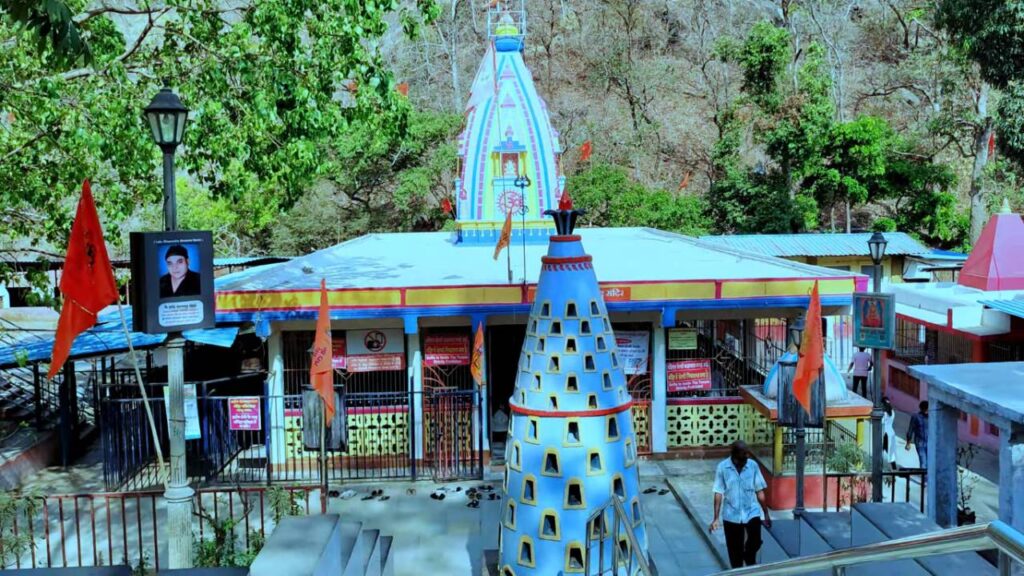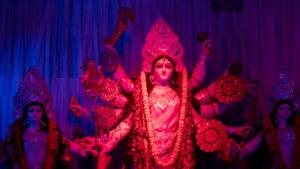Tungareshwar Temple is a peaceful Shiva shrine located atop a hill in the Tungareshwar Wildlife Sanctuary, Maharashtra. Surrounded by dense forests and hills, it offers spiritual calm along with stunning views, including sights of the Arabian Sea on clear days. The sanctuary, covering over 85 sq km, is rich in wildlife and popular among trekkers and bird watchers. The temple draws many devotees, especially during Maha Shivratri. This will covers the temple’s location near Mumbai, visiting hours, best times to visit, and nearby activities.
Tungareshwar Temple Location
Tungareshwar Temple is located in the Palghar district of Maharashtra, within the boundaries of the Tungareshwar Wildlife Sanctuary. This sanctuary is a protected forest area recognized for its ecological importance, situated on the Western Ghats, a mountain range famous for its rich biodiversity and designated as a UNESCO World Heritage site. The temple is perched on one of the hills of the Tungareshwar range, which is covered with dense forests, rocky terrains, and several small streams and waterfalls. This hilltop location provides a tranquil atmosphere far removed from city noise and pollution, making it a perfect place for meditation and worship.
The closest urban center to the temple is Vasai West, which acts as the main gateway for visitors traveling from Mumbai or other nearby towns. Surrounding the temple are vast stretches of untouched forests where visitors can often spot animals such as monkeys, deer, and various birds, adding an element of wildlife excitement to their visit. The sanctuary’s environment remains largely pristine, which has helped maintain the temple’s serene and mystical aura.
Shree Siddhivinayak Ganapati Mandir: History, Timings, Aarti, Address!
The temple’s elevation not only offers spiritual upliftment but also stunning views of the natural surroundings. Visitors can enjoy the panoramic vistas of the forest canopy stretching endlessly, and on particularly clear days, they may even catch a glimpse of the Arabian Sea far in the distance, lending a breathtaking backdrop to the temple experience. The fusion of spiritual sanctity and natural beauty makes Tungareshwar Temple a one-of-a-kind destination.
Tungareshwar Temple Distance from Mumbai
Travelers from Mumbai find Tungareshwar Temple conveniently located about 55 to 60 kilometers from the city center. This proximity makes it an excellent destination for day trips or weekend getaways for those seeking spiritual peace or outdoor adventure near the bustling metropolis. Depending on Mumbai’s traffic, the journey usually takes 1.5 to 2 hours by road.
Visitors typically travel northwards via the Western Express Highway or Mumbai-Ahmedabad Highway, then turn off towards Vasai West. Vasai acts as a key transit hub, well connected by both road and rail. The region has witnessed infrastructure upgrades in recent years, making the drive smoother and safer.
Besides Mumbai, people from nearby towns like Nalasopara and Palghar also visit Tungareshwar Temple, making it a popular spiritual and natural hub for the region. Many combine their visit with trips to Vasai Fort, Arnala Beach, or other nature trails in Palghar, enriching their overall experience. Despite its closeness to the city, Tungareshwar offers a peaceful and pristine environment that rejuvenates visitors.
How to Reach Tungareshwar Temple
You can reach Tungareshwar Temple via several transport options, depending on your preference for convenience, budget, and adventure.
By Road
If you enjoy the flexibility of personal transport, driving is the easiest way to get there. From Mumbai, take the Western Express Highway or Mumbai-Ahmedabad Highway heading north. After about 40 to 50 kilometers, exit at Vasai Road or Nalasopara. Local roads then lead you to the base of Tungareshwar hill. The final stretch involves narrow roads through dense forests, requiring cautious but scenic driving.
Many visitors use private cars, taxis, or two-wheelers. Parking facilities near the trekking trail entrance accommodate vehicles comfortably. For groups or families, hiring a cab or private vehicle ensures a hassle-free journey.
By Train
The Western Railway Line connects Mumbai to Vasai Road and Nalasopara stations, the closest railway stops to the temple. These stations integrate smoothly with Mumbai’s local train system, offering an economical and efficient travel choice that avoids road traffic.
Once you arrive at Vasai or Nalasopara, you can hire auto-rickshaws or taxis to cover the remaining 5 to 10 kilometers to the temple base. Plan your train schedules carefully to sync with temple timings and local transport availability. While affordable, the last leg of the journey may involve some walking or waiting, so it suits visitors comfortable with a bit of adventure.
Trekking Routes
For adventurous travelers, trekking to Tungareshwar Temple provides a rewarding way to connect with nature. Popular trails start from Varai village or Vasai, with trek distances ranging from 4 to 7 kilometers depending on the path.
The routes wind through thick forests, rocky patches, streams, and occasional waterfalls, immersing trekkers in natural beauty. The terrain is moderately challenging and requires good physical fitness, sturdy footwear, and plenty of water. Local guides at the base offer valuable insights into the sanctuary’s flora and fauna and can enhance your trekking experience. Trekking not only adds excitement but also allows you to experience the sanctuary intimately.
Best Time to Visit Tungareshwar Temple
Choosing the best time to visit Tungareshwar Temple depends on your priorities, whether it’s pleasant weather, spiritual festivals, or scenic beauty.
Ideal Season: October to March
From October through March, the weather remains cool and pleasant, perfect for trekking and outdoor activities. Temperatures typically range from 15°C to 30°C, creating comfortable conditions for exploring the forested hills.
This period also features major festivals like Maha Shivratri, drawing large numbers of devotees. Clear skies during these months provide spectacular views and excellent photo opportunities.
Monsoon Season: June to September
The monsoon transforms the sanctuary into a lush green paradise, with cascading waterfalls and vibrant foliage. Visitors witness nature at its most refreshing and beautiful.
Trekking during the monsoon requires caution because trails become slippery and muddy. Only experienced trekkers with rain gear and sturdy shoes should attempt the trek. Heavy rains might also cause temporary closures of some paths. Always check local weather and sanctuary updates before visiting in the monsoon.
Summer Season: April and May
Summer brings hot and humid weather, with temperatures sometimes soaring above 35°C. The heat can make trekking strenuous and uncomfortable during midday hours. To beat the heat, plan your visit early in the morning or late afternoon. Those sensitive to heat may find summer less ideal for outdoor activities.
Tungareshwar Temple Timings
Tungareshwar Temple remains open year-round, offering flexible visiting hours for different schedules. The temple opens at 6:00 AM, welcoming early visitors who seek the serenity of morning prayers and meditation. Morning hours are especially peaceful, ideal for spiritual reflection.
The temple closes by 7:00 PM, allowing visitors to enjoy sunset views from the hilltop before departing. During festivals like Maha Shivratri, the temple often extends its hours to accommodate large crowds and organize special rituals. To avoid surprises, always confirm the timings with temple authorities or local sources before your visit.
Tungareshwar Temple Entry Fee
The temple charges no entry fee, welcoming all pilgrims and tourists free of cost. This accessibility encourages people from all backgrounds to experience its spiritual and natural beauty without financial barriers.
While entry to the temple and immediate premises is free, some ancillary activities may require small fees. For example, guided trekking tours and nature walks within the sanctuary sometimes involve a nominal charge to cover guide services and sanctuary upkeep. Parking near the trekking base might also have a minor fee depending on vehicle type.
Visitors should support local vendors offering refreshments, handicrafts, and souvenirs, which helps sustain the local economy. Importantly, the sanctuary enforces strict environmental rules — visitors must avoid littering and respect wildlife to keep this pristine area intact for future generations.
Things to Do Near Tungareshwar Temple
Beyond the temple visit, the surrounding area offers plenty of activities that enrich your trip and showcase the sanctuary’s natural splendor.
Trekking and Nature Walks
Tungareshwar Wildlife Sanctuary provides trekking trails ranging from easy to moderately difficult. These paths traverse dense forests, rocky hills, and refreshing waterfalls, offering multiple scenic resting points and photo opportunities. Trekking here allows you to immerse yourself in nature, observe wildlife, and enjoy clean forest air.
Bird Watching
The sanctuary hosts over 150 bird species, making it a haven for bird watchers. You can spot colorful kingfishers, raptors, woodpeckers, and melodious songbirds year-round. Winters bring migratory species that add diversity and excitement. Carry binoculars and cameras with zoom lenses to capture the birdlife in its natural habitat.
Photography
Photographers will find abundant subjects—from panoramic landscape shots during sunrise or sunset to close-ups of flora, insects, and birds. Each season offers unique visual opportunities, making every visit distinct.
Waterfalls and Natural Pools
Several small waterfalls and natural pools dot the trekking trails, especially during monsoon. These spots provide refreshing breaks and deepen your connection with nature. Be cautious as wet rocks can be slippery.
Picnic Spots and Nearby Attractions
You’ll find peaceful clearings near the temple and along trekking routes ideal for picnics. Bringing packed meals lets you relax surrounded by nature. Nearby attractions like the historic Vasai Fort and tranquil Arnala Beach add cultural and recreational variety. History buffs enjoy exploring the Portuguese-era Vasai Fort, while Arnala Beach offers a soothing seaside retreat after trekking.
Local Culture and Cuisine
Nearby villages showcase traditional Maharashtrian rural life. You can explore local markets selling handicrafts and taste authentic regional foods such as puran poli, bhakri, and fresh coconut water. Interacting with villagers enriches your journey and gives insight into local customs and hospitality.
Global Vipassana Pagoda: History, Timing, How to Reach!
FAQs
1. Where is Tungareshwar Temple located?
Tungareshwar Temple sits atop a hill within the Tungareshwar Wildlife Sanctuary near Vasai, in Palghar district, Maharashtra. It’s roughly 55–60 km north of Mumbai.
2. How can I reach Tungareshwar Temple from Mumbai?
You can reach the temple by road via the Western Express Highway or Mumbai-Ahmedabad Highway. Alternatively, take a local train to Vasai Road or Nalasopara, and then hire an auto or cab to reach the base.
3. What is the best time to visit Tungareshwar Temple?
The ideal time to visit is between October and March, when the weather is cool and trekking conditions are favorable. Monsoon offers lush beauty but can be risky for trekking.
4. Is there an entry fee for Tungareshwar Temple?
No, entry to the temple is completely free for all visitors. You might pay small fees for parking or optional guided treks within the sanctuary.
5. What are the temple timings?
Tungareshwar Temple opens daily from 6:00 AM to 7:00 PM. During festivals like Maha Shivratri, timings may extend to accommodate the influx of devotees.
6. Can I trek to the temple?
Yes, you can trek to the temple from Vasai or Varai village. The trek ranges between 4 to 7 km and passes through forests, streams, and waterfalls—perfect for nature enthusiasts.
7. Is Tungareshwar Temple suitable for family visits?
Absolutely. Families can enjoy a mix of spiritual experience, scenic beauty, and mild adventure. There’s ample parking and picnic spots available near the temple trail.
8. What festivals are celebrated at Tungareshwar Temple?
Maha Shivratri is the most prominent festival, drawing thousands of devotees. Other Hindu festivals like Shravan Maas and Kartik Purnima also attract visitors.
9. Are there food and water facilities available?
You’ll find small food stalls and refreshment vendors near the base and along the trail. It’s still advisable to carry your own water and snacks, especially during treks.
10. Is the temple child- and elderly-friendly?
Yes, but with caution. The road approach is suitable for elders and children, while trekking requires basic fitness. You can choose to drive or walk, depending on convenience.






